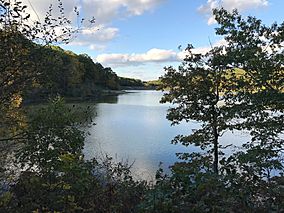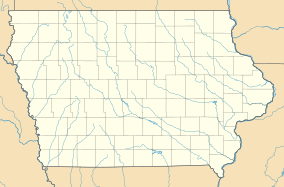Lacey-Keosauqua State Park facts for kids
Quick facts for kids Lacey-Keosauqua State Park |
|
|---|---|

Lacey-Keosauqua State Park
|
|
| Location | Van Buren, Iowa, United States |
| Area | 1,653 acres (6.69 km2) |
| Elevation | 732 ft (223 m) |
| Established | 1921 |
| Governing body | Iowa Department of Natural Resources |
| Website | iowadnr.gov |
|
Lacey-Keosauqua State Park
Lodge and Picnic Area (Area A) Picnic and Custodial Group (Area B) Bathing Area (Area C) |
|
| Built | 1933-1936 |
| Built by | Civilian Conservation Corps |
| Architect | Central Design Office, Ames |
| Architectural style | Rustic |
| MPS | CCC Properties in Iowa State Parks MPS |
| NRHP reference No. | 90001668 90001669 90001670 |
| Added to NRHP | November 15, 1990 |
Lacey-Keosauqua State Park is a large and beautiful state park in Iowa, located southwest of Keosauqua, Iowa. It sits right along the Des Moines River in Van Buren County. The park was officially opened in 1921. It's actually the biggest state park in Iowa! In 1990, three special parts of the park were recognized as historic districts. They were added to the National Register of Historic Places because of their important history.
Contents
History of Lacey-Keosauqua State Park
The land for the park was once a huge farm. A group of local people raised $64,000 to buy it. The state of Iowa then got the land in 1920. It was first called Big Bend Park when it opened in 1921.
Over the years, the park grew in size. It started with about 1,222.1 acres (494.6 ha) in 1923. By 1942, it had grown to 2,209.85 acres (894.29 ha). Today, the park is about 1,653 acres (669 ha) large, making it the biggest state park in Iowa.
In 1926, the park was renamed to honor John Fletcher Lacey. He was an American Civil War veteran. Later, he served in the government for Iowa and the United States. John F. Lacey was known for his work in conservation. He helped create the state park system in Iowa. By 1933, the park had a lodge and a golf course, but the golf course is no longer there.
Building the Park: The 1930s and 1940s
Many government groups helped build Lacey-Keosauqua State Park. This happened during the 1930s and 1940s.
- The Civilian Conservation Corps (CCC) was a program that employed young men during the Great Depression. CCC Company 770 arrived in May 1933. They worked with the National Forest Service. They helped with landscaping and stopping soil erosion along the river bluffs.
- Later, the CCC company worked with the National Park Service. Their main job was to build the earthen dam and concrete spillway. This created the park's man-made lake.
- Another CCC group, Company 2719, worked in the park from 1934 to 1935. Most of the park's trails were finished in 1934. The National Forest Service and both CCC companies built many of the park's buildings.
- The Works Progress Administration (WPA) also helped. This was another program that provided jobs during the Great Depression. From 1935 to 1936, the WPA built footbridges and vehicle bridges in the park.
- The state of Iowa built some of the park's cabins between 1940 and 1942. They finished the rest of the cabins after 1942.
Historic Areas of the Park
On November 15, 1990, three parts of the park became historic districts. They were added to the National Register of Historic Places. These areas have 37 important historical structures. All the old buildings in the park were designed in the rustic style. This style uses natural materials like stone and wood. They were designed by the Central Design Office in Ames.
Lodge and Picnic Area (Area A)
Area A is in the northwest part of the park. It includes several historic buildings and structures.
- There is a gatehouse and two stone entranceways called portals. The south portal is about 8.3 feet (2.5 m) tall. The north portal is about 9 feet (2.7 m) tall.
- The lodge is a two-story, L-shaped building. It has a porch that wraps around parts of it.
- An underground pump house is near the lodge. It has double wooden doors.
- The picnic shelter is about a quarter-mile from the pump house. It is made of stone and built into the side of a hill. It has restrooms inside.
Picnic and Custodial Group (Area B)
Area B is in the north-central part of the park. It has historic buildings for picnics and park staff.
- The custodian's residence is a one-story stone building. It has a basement and is located in a clearing.
- The picnic area has a stone shelter with a fireplace.
- Two stone restrooms are located near the shelter.
- There is also a water fountain.
- The entrance to the picnic area has four square cement posts and two stone walls. Two long stone walls, about 408-foot (124 m), are in the parking lot.
Bathing Area (Area C)
Area C is near the center of the park, south of Area B. This area is for swimming and includes the lake.
- The park has a 30-acre (12 ha) lake. It is fed by a spring.
- There is an earthen dam with a concrete core, about 450 feet (140 m) long. Rocks protect the dam from erosion.
- A 300-foot (91 m) concrete spillway curves to the west. A steel bridge, about 55-foot (17 m), goes over the spillway.
- Most of the lake is surrounded by a trail that is about 3.25-mile (5.23 km) long. Along the trail, there are ten small dams called check dams. They help stop soil from washing into the lake.
- Two stone footbridges are south of the lake. One of them was built by the WPA.
- The bathhouse is a one-story stone building near the lake. It has a central gable and two side wings. Stone steps lead down to the beach.
- A stone pump house is built into the hillside. It has a flat stone roof.
Land Use and Activities
Lacey-Keosauqua State Park offers many things to do.
- There are nineteen ancient burial mounds from the Woodland Period in the northwest part of the park. Visitors can see them.
- The lake in the center of the park is great for swimming, boating, and fishing.
- You can also fish in the Des Moines River.
- The park has many trails for hiking. These trails go along the lake, river bluffs, and valleys.
- For those who want to stay overnight, there are cabins and campsites.
- Picnic areas are also available for day visitors.
- Part of Shimek State Forest is right next to the park.


